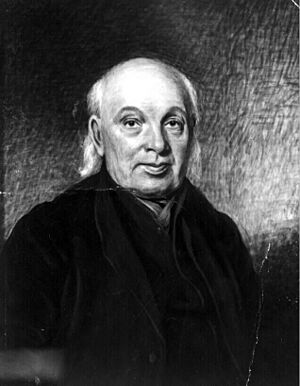James Finlayson (industrialist) facts for kids
James Finlayson (born around 1772, died around 1852) was a British man who helped bring new ways of making things to Finland. He was a Quaker, a member of a Christian group. In 1820, he started the famous Finlayson company in Tampere, Finland. This company became very important for the city.
James Finlayson was born in Penicuik, Scotland. He taught himself to be an engineer. In 1817, he moved to St. Petersburg, Russia. There, he started a factory that made cloth with help from the Russian ruler, Tsar Alexander I of Russia.
In 1819, Finlayson visited the Grand Duchy of Finland. At that time, Finland was ruled by Russia. He visited Tampere during his trip. The next year, Finlayson got permission from the Finnish government to build a factory in Tampere. He planned to use water power from the Tammerkoski rapids. He moved to Tampere with his wife, Margaret Finlayson.
Starting the Factory
At first, James Finlayson had to bring skilled workers from Britain. These workers helped train new people in Finland. The first factory building was finished in 1823. The government helped with a loan. They said that anyone could inspect the factory's technology. This was to help new ideas spread.
Initially, Finlayson made machines for the cloth industry. But in 1828, he changed his focus. He started making cotton mills instead. These mills spun cotton into thread. He also started an orphanage to help children.
Finlayson & Compagnie

On March 1, 1836, Finlayson sold his factory. The new owners were Georg Rauch and Karl Samuel Nottbeck. Finlayson had one condition: they had to keep his name for the factory. The new owners agreed. They named the company Finlayson & Compagnie.
James Finlayson stayed on as an advisor for a few years. Then, he moved back to the United Kingdom. He passed away in 1852 in Edinburgh, Scotland.
The Finlayson company grew very large. It became Tampere's biggest employer. At its busiest, it had over 3,000 workers. The company still makes textiles today. In 1995, the old factories in the center of Tampere closed. The historic buildings were then turned into shops and places for fun.
The Plevna Building
A large building for weaving was completed in 1877. At that time, it was the biggest in the Nordic countries. It held 1,200 power looms. These machines wove thread into fabric. It was named Plevna after a famous battle called the Siege of Plevna. This was a common way to name important new buildings. Today, the Plevna building has a restaurant that brews its own beer. It also has a cinema multiplex called Finnkino Plevna.
Early Electric Lighting
The Plevna building was very special. It was the first building in any Nordic country to have electric lights. It was also the fourth in all of Europe! The lights were turned on for the first time on March 15, 1882. There were 120 light bulbs, each giving off light like 8 candles.
The system used a special machine called an Edison "dynamo" No. 24. This machine is still in the building today. The system used 110 volt direct current. This type of electricity was then used for all of Tampere. Later, a different type of electricity, alternating current, was introduced. This led to a "war of currents" between the two systems.


